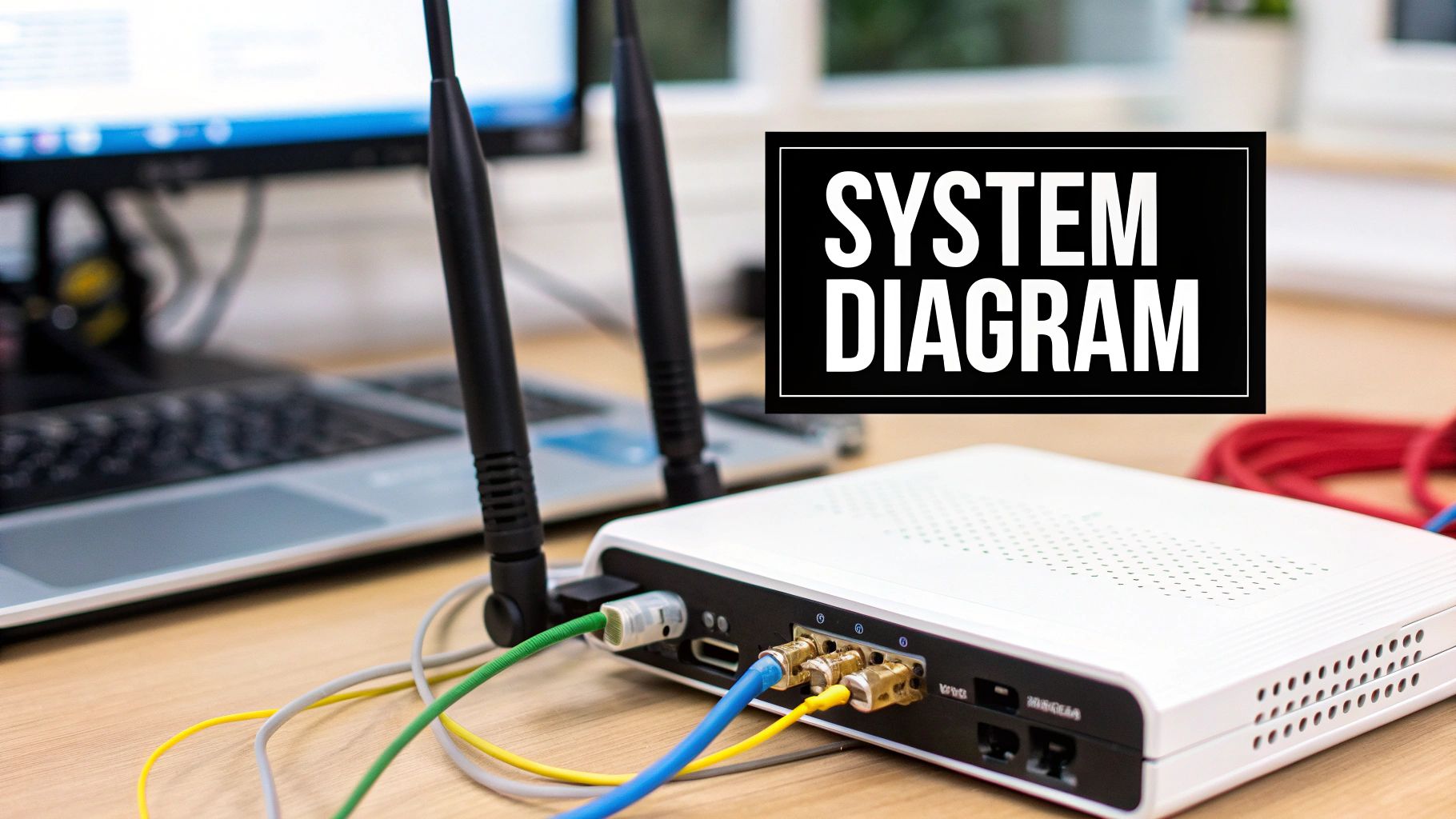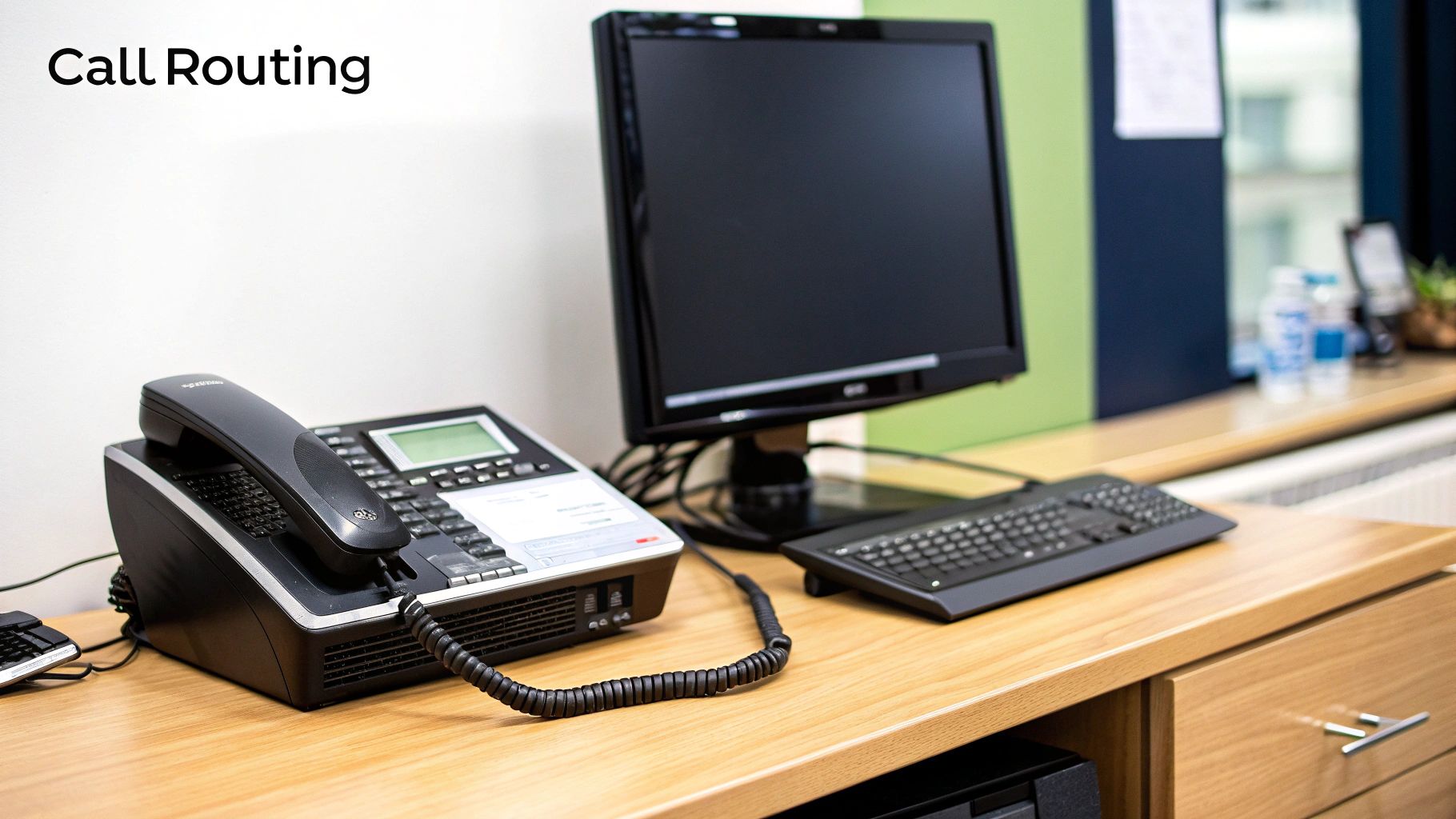A GSM gateway is a specialized piece of hardware that bridges the gap between your office phone system and the cellular network. Think of it as a smart middleman that lets your traditional landline or VoIP network speak directly with mobile phones.
The main idea is simple but powerful: cut communication costs and build in a reliable backup for your phone lines by smartly routing calls over the most affordable path available—the mobile network.
What Is a GSM Gateway and How Does It Help Your Business?
Let's break it down. Your business likely has an internal phone system, maybe a VoIP setup or a classic PBX. At the same time, your customers, partners, and employees are all using their mobile phones. These two worlds don't naturally connect without going through expensive traditional phone carriers. This is where a GSM gateway steps in.
The device itself is a box loaded with one or more SIM cards, exactly like the ones in your personal smartphone. When someone in your office dials a mobile number, the gateway catches the call before it goes out over your pricey landline. It then cleverly pushes the call through one of its internal SIM cards, instantly turning it into a much cheaper mobile-to-mobile call.
The Core Function: A Simple Analogy
Imagine you need to send a package. You could use a premium international courier for every single delivery—reliable, but you'll pay a premium, especially for local shipments. A smarter way would be to use a local courier for nearby destinations. It's just as fast and far more cost-effective.
A GSM gateway is your company's automated dispatch manager for phone calls. It instantly analyzes where a call is going and chooses the cheapest route, saving you money on every single call to a mobile phone.
This isn't just a niche tool; it's becoming a central part of modern business communication strategy. The market growth tells the story.
The GSM gateway market was valued at USD 4.43 billion and is projected to reach USD 11.2 billion by 2032, growing at a compound annual growth rate (CAGR) of 12.3%. This global surge is mirrored in the MEA region, where rising mobile device usage and expanding IoT applications are accelerating demand for reliable, secure communication infrastructure. You can explore more about these market trends and their implications in the full report.
GSM Gateway At a Glance
To put it all together, here’s a quick summary of what a GSM gateway brings to the table and the direct advantages for your business.
| Feature | Description | Primary Benefit |
|---|---|---|
| Call Routing | Automatically routes calls between a PBX/VoIP system and a mobile network. | Cost Savings: Turns expensive landline-to-mobile calls into cheaper mobile-to-mobile ones. |
| Cellular Failover | Provides a backup communication channel via the mobile network if landlines or internet fail. | Business Continuity: Ensures your phone system stays online during outages, preventing lost calls and revenue. |
| SMS Integration | Enables sending and receiving SMS messages directly from business applications. | Enhanced Communication: Opens up a direct channel for marketing, alerts, and customer notifications. |
From this, it's clear that a GSM gateway isn't just about one single feature but a combination of functions that solve real-world business challenges.
Primary Benefits for Your Business
A GSM gateway delivers immediate, practical value to any organization that makes frequent calls to mobile numbers. The advantages tackle common pain points like high costs, service interruptions, and communication gaps.
-
Significant Cost Reduction: The most obvious win. By converting what your phone company bills as a fixed-to-mobile call into a simple mobile-to-mobile call, you can dramatically lower your monthly phone bill. Often, these calls fall under bundled minutes in a business mobile plan.
-
Enhanced Business Continuity: What happens if your office internet goes down? Or a physical phone line gets cut? With a GSM gateway, your business doesn't go silent. It acts as an instant failover, keeping your lines open by routing all calls through the cellular network until your primary service is restored.
-
Increased Communication Flexibility: The gateway isn't just for voice calls. It also opens up a powerful channel for sending and receiving bulk SMS messages right from your CRM or other business software. This is perfect for running marketing campaigns, sending appointment reminders, or dispatching urgent alerts.
A Look Inside a GSM Gateway
To really get what a GSM gateway can do for a business, you have to pop the hood and see what makes it tick. It might look like just another piece of office hardware, but inside, it's a sophisticated device where hardware and software work together to bridge the gap between your phone system and the mobile world. Knowing these core components is crucial for picking the right device and getting the most out of it.
Think of a GSM gateway as a specialized computer with one job: to flawlessly manage calls between your internal phone system and the cellular network. Every part has a specific, vital role in making that happen, from catching a signal to intelligently routing the call.

The Essential Hardware Components
The physical parts of the gateway are what connect it to different networks. You can think of these as the hands, ears, and brain of the operation. Each one handles a specific task to keep calls flowing smoothly. Let’s break down the key hardware you’ll find in any GSM gateway.
-
SIM Card Slots: This is where it all starts. Each slot holds a SIM card, giving the device an identity on a mobile network. The number of slots—often called ports—dictates how many simultaneous calls the gateway can handle. A 4-port gateway can manage four calls at once, while a 32-port model can handle thirty-two.
-
Antennas: Just like on your smartphone, antennas are absolutely essential for getting a strong, stable cellular signal. High-quality external antennas are usually best because you can position them for maximum reception, which is critical for clear call quality. Without a good signal, calls become unreliable.
-
Central Processing Unit (CPU): This is the gateway's brain. The CPU manages everything, from processing call requests to executing the routing rules you’ve set up. A more powerful CPU can juggle higher call volumes and more complex logic without skipping a beat.
-
Network (Ethernet) Ports: These ports are the gateway's link to your office's local area network (LAN). This connection is how it communicates with your internal VoIP or PBX system, taking calls from office phones and sending them out over the cellular network.
The Software That Runs the Show
Of course, hardware is only half the story. It's the sophisticated software, known as firmware, that truly brings the device to life. This internal software is what makes the gateway smart, turning a simple box of electronics into a powerful communication hub that you can fine-tune to your exact needs.
Key software functions include:
-
Call Routing Engine: This is where you set the rules of the road for your calls. For instance, you can program the gateway to automatically route all calls to mobile numbers through its SIMs, while calls to landlines use your traditional phone lines.
-
Security Protocols: The firmware comes equipped with security features to block unauthorized access and prevent costly toll fraud. This includes things like access control lists and password protection to keep your communication lines secure.
-
Management Interface: This is your command center—a web-based dashboard where you configure and monitor the gateway. From here, you can review call logs, check signal strength, update routing rules, and perform system maintenance.
These pieces all work together to create a seamless bridge. When someone in your office dials a mobile number from their desk phone, the call travels to the gateway over your network. The gateway's CPU processes the request, picks an available SIM card, and places the call over the cellular network. This is similar to how an IP SIP trunk connects VoIP systems, but it uses mobile networks instead of fixed internet lines.
A GSM gateway essentially miniaturizes the function of a mobile phone and multiplies it. Each port acts like a dedicated mobile phone, ready to make or receive a call on behalf of your entire office phone system. This architecture is what delivers both cost savings and system redundancy.
Ultimately, understanding these inner workings demystifies the technology. It helps you look past the marketing jargon and evaluate different models based on their real-world components and capabilities. This way, you can invest confidently in a GSM gateway that truly fits your operational needs and future growth.
The Real-World Benefits of Using a GSM Gateway
Let's move past the hardware and technical specs for a moment. The real reason businesses get excited about a GSM gateway is what it does for them day-to-day. This isn't just about fancy technology; it's about tangible improvements to your bottom line, better operational resilience, and smarter ways to connect with customers. These are practical, measurable advantages that solve common business headaches.
At its heart, a GSM gateway is a brilliant cost-optimization tool. Think about it: every time an employee calls a mobile number from their office phone, that call gets routed over an expensive fixed-line-to-mobile network. A gateway cleverly steps in, grabs that call, and sends it through an internal SIM card instead. Just like that, an expensive call becomes a much cheaper mobile-to-mobile one. This simple rerouting can seriously slash your monthly telecom bills.

Driving Down Communication Costs
The most immediate and celebrated benefit is, without a doubt, significant cost savings. Picture a sales team that spends all day calling prospects on their mobile phones. Without a gateway, every one of those calls racks up premium charges on your phone bill. With a gateway in place, those same calls can be covered by a bulk-minute business mobile plan, cutting your costs dramatically.
While gateways are fantastic for streamlining communication costs, they fit into a bigger picture of financial prudence. For a wider view on optimizing spending, it's worth exploring how to implement effective IT cost reduction strategies. This kind of strategic investment often pays for itself quickly through lower operational overhead.
Ensuring Uninterrupted Business Continuity
What happens if your office internet goes out or the landline service fails? For too many businesses, it means communication grinds to a halt. Sales opportunities are lost and customers get frustrated. This is where a GSM gateway acts as a robust and automatic failover system.
If your primary lines go down, the gateway seamlessly reroutes all inbound and outbound calls through the cellular network. It’s a simple, elegant solution that ensures your business stays connected and operational, maintaining a professional image even during an outage. It’s a critical piece of any modern business continuity plan.
A GSM gateway is more than a cost-saving device; it's an insurance policy for your business's voice communications. It guarantees that a single point of failure—like a cut cable or internet disruption—won't silence your entire operation.
Advanced Applications and Scalability
The usefulness of a GSM gateway doesn't stop at just routing voice calls. Modern gateways are versatile workhorses that open up new communication channels and can grow right alongside your business.
-
Bulk SMS Marketing and Alerts: Many gateways let you send and receive SMS messages directly from business applications, like your CRM. This is perfect for sending out promotional offers, appointment reminders, delivery notifications, or urgent internal alerts—reaching customers on a channel that feels personal and immediate.
-
Seamless CRM Integration: When you integrate a gateway with your CRM platform, you can automate key workflows. For instance, every outbound call made through the gateway can be logged automatically in the customer's record, giving your sales and support teams a complete, up-to-the-minute interaction history.
-
Effortless Scalability: As your business grows, so will your communication needs. Scaling up with a GSM gateway is refreshingly straightforward. If you need to handle more simultaneous calls, you simply upgrade to a model with more ports and pop in more SIM cards. This built-in scalability ensures the solution grows with you, not against you.
This adaptability makes the technology especially powerful in dynamic markets. For example, a major driver of GSM gateway adoption in the AE region has been the explosion in mobile money and digital financial services. One industry report noted that active mobile money accounts in regions like MEA grew by 11% year-on-year to hit 514 million. This boom highlights just how critical robust mobile network infrastructure is, and gateways are a foundational part of that. You can discover more about the state of mobile money in the full GSMA analysis.
How Businesses Are Using GSM Gateways Today
It's one thing to understand the theory behind a GSM gateway, but it's another to see it in action. So, let's explore some real-world scenarios where these devices are making a tangible difference for businesses right now. Seeing how others have solved concrete problems can give you a playbook of ideas for your own operational challenges. From cutting call costs to keeping remote sites connected, the GSM gateway is a surprisingly versatile tool.
We'll look at how different industries are using this technology to boost efficiency, trim overhead, and improve their communication lines. The pattern is pretty straightforward: a common business problem finds a solution in a GSM gateway, leading to a clear, positive outcome.

Slashing Outbound Calling Costs in Call Centers
The Problem: Outbound call centers and sales teams practically live on the phone. A massive chunk of their calls go to mobile numbers, and traditional landline-to-mobile rates are notoriously expensive. These high costs add up quickly, creating a huge monthly telecom bill that eats directly into profit margins.
The Solution: Here, a multi-port GSM gateway is plugged directly into the call center's existing PBX or dialing system. Now, all outbound calls heading to a mobile number are automatically routed through the gateway. Instead of paying those premium rates, the calls are made using business SIM plans that offer bulk minutes or flat-rate mobile-to-mobile calling.
The Result: The impact is immediate. The call center sees a dramatic drop in its communication overhead—often with savings reaching 50-70% on outbound call spending. That freed-up capital can be reinvested into hiring more agents, upgrading technology, or boosting marketing efforts.
Enabling Instant Communication for Temporary Sites
The Problem: Think about industries like construction, event management, or even disaster relief. They often work from temporary sites where getting traditional landlines installed is slow, costly, or just plain impossible. But these operations still need reliable phone and data from day one to coordinate logistics, manage staff, and ensure safety.
The Solution: A GSM gateway becomes the instant communication hub on-site. When paired with a VoIP phone system, it gives the entire team immediate access to voice calling. All it needs is a power outlet and a decent cell signal, which can easily be strengthened with an external antenna if needed.
The Result: The temporary site is fully connected in hours, not weeks. Teams get reliable phone lines for all their calls, completely bypassing the long waits and high costs of getting a fixed line installed. This kind of agility is essential for projects on a tight deadline or in remote areas.
A GSM gateway is like a "pop-up" phone system. It brings the robust communication infrastructure of a permanent office to any location with a cell signal, making it an indispensable tool for businesses on the move.
Powering Bulk SMS Marketing and Alert Systems
The Problem: Businesses need to reach customers directly for promotions, appointment reminders, and critical alerts. Email is fine, but open rates can be disappointingly low. Text messages, on the other hand, are almost always read immediately—studies show open rates as high as 98%. The challenge is that you can't send SMS in bulk from a standard phone, and online services can get pricey.
The Solution: A GSM gateway with SMS capabilities is connected to the company's CRM or marketing software. This setup allows the business to send thousands of personalized text messages right from the applications they already use. The messages go out through the gateway's SIM cards, taking advantage of affordable bulk SMS packages offered by mobile carriers.
The Result: The business suddenly has a powerful, direct, and incredibly cost-effective marketing channel. This translates to higher engagement for promotions, a big drop in costly no-shows for appointments, and a way to instantly send urgent information to staff or customers. For instance, some healthcare providers have cut patient no-show rates by 30–40% just by adding SMS reminders. It's a direct line that builds stronger relationships and makes operations run smoother.
Connecting Your Gateway to Modern Phone Systems
A GSM gateway is a powerful piece of kit on its own, but its real magic happens when you connect it to your company's communication hub. By integrating it with your Voice over IP (VoIP) or cloud PBX system, you transform it from a simple device into a central part of your cost-saving and business continuity plan. This is the link that lets your entire team tap into cheaper mobile calling rates and stay online even if your primary internet connection fails.
This might sound incredibly technical, but it’s all based on a standard that’s been the backbone of modern telephony for years: the Session Initiation Protocol (SIP). Think of SIP as the universal translator for phone systems. It's the common language that allows your PBX and your GSM gateway to understand each other—to start, manage, and end calls. When you set up a SIP connection, you're essentially teaching your phone system how to route calls out through the gateway.
Getting this connection just right often requires a bit of specialized know-how. Partnering with providers of IT services for VoIP solutions can make the whole process feel effortless, ensuring a solid and secure setup from the get-go.
The Integration Blueprint: SIP Trunks and Call Routing
The first technical step is to create a SIP trunk. It's helpful to picture this as building a digital bridge directly between your PBX and the GSM gateway. This bridge is the SIP trunk—a private, secure pathway that lets voice traffic flow between the two. You’ll set this up in your phone system’s control panel by simply pointing it to the gateway's network address.
Once that bridge is built, the real intelligence comes into play. You need to define call routing rules. These are the specific instructions you give your PBX so it can make smart, automatic decisions about where to send every outbound call. For example, a common rule would be: "If a dialed number starts with a mobile prefix, send that call over the GSM gateway's SIP trunk."
For all other calls, like those to landlines or international destinations, the system can default to your regular internet phone provider. This automated routing means every call takes the most cost-effective path without anyone on your team having to do a thing. For the user, it’s completely seamless—they just dial the number as they always have.
The following graphic breaks down the key stages of getting your GSM gateway deployed, from the initial planning to the final configuration.

Following a structured approach like this ensures every detail is handled correctly for a successful deployment, from the initial site check to the final network setup.
Best Practices for Security and Call Quality
A successful integration isn't just about making the connection; it's about making it work well. You need it to be secure, reliable, and deliver crystal-clear audio. Keeping call quality high and your system protected from threats should be your top priorities.
First, let's talk about the network. To get that crisp, uninterrupted audio, your voice traffic needs VIP treatment. This is done with Quality of Service (QoS) settings on your network router. QoS tells your router to prioritize voice data packets over everything else, like large file downloads or emails. This simple step prevents the jitter and lag that can make calls sound choppy or robotic.
Think of QoS as an express lane on a busy highway, reserved exclusively for your phone calls. No matter how much traffic builds up in the other lanes, your calls have a clear, fast path to their destination.
Security is just as crucial. An unsecured gateway is a prime target for toll fraud, where hackers can hijack your system to make thousands of dollars in unauthorized calls on your dime. To lock things down, you must implement a few key security measures:
- Strong Passwords: The first thing you should do is change the default administrative passwords on your gateway. Make them long, complex, and unique.
- Access Control Lists (ACLs): Configure your gateway to only accept SIP traffic from your PBX's specific IP address. This acts like a bouncer, blocking any connection attempts from unknown sources.
- Regular Firmware Updates: Just like any software, your gateway's firmware needs to be kept up-to-date. These updates patch security holes as they're discovered.
By sticking to these best practices, you build a resilient and secure bridge between your GSM gateway and your main communication platform. This ensures you get all the cost savings and reliability without ever sacrificing performance or security. For many companies, this integration is a key part of a smarter, more affordable https://cloud-call-center.ae/2025/05/04/small-business-phone-system-voip/.
Answering Your Key Questions About GSM Gateways
When you're looking at bringing new tech into your business, questions are a given. A GSM gateway is a serious investment, and you need straight answers to feel good about the decision. This section is designed to clear up the most common questions and concerns we hear from business leaders and IT managers before they pull the trigger.
We'll cover everything from the legal fine print and technical specs to practical things like call capacity. The goal here is to get rid of any doubt so you can make a smart, informed choice for your company.
Is Using a GSM Gateway Legal?
This is usually the first question people ask, and it's a critical one. The short answer is: it depends entirely on your country's telecom regulations. There’s no single, universal rule.
In many places, including most of the UAE, using a gateway to route your own company's outbound calls through a PBX system is completely above board. It's actually a pretty common way to save on costs. The important distinction is that you are routing your own business traffic onto the mobile network.
However, some countries have very strict rules or have banned them altogether. This is often to prevent a practice known as SIM box fraud, where operators use gateways to illegally terminate international calls and bypass official carrier fees.
Crucial Takeaway: Before you even think about buying a GSM gateway, you absolutely must check the specific rules with your local telecommunications authority. This one step will keep you compliant and save you from facing serious legal trouble down the road.
What Is the Difference Between a GSM and a VoIP Gateway?
It’s easy to get these two mixed up, but the difference is actually quite simple. Think of a GSM gateway as a highly specialized tool. Its one and only job is to create a bridge between your digital phone system (like a VoIP PBX) and the cellular network, using standard SIM cards.
A general VoIP gateway is a much broader term. It's a device that usually connects a traditional phone network—like old-school analog lines or ISDN—to a modern VoIP network.
Here's a simpler way to look at it:
- A GSM gateway connects your office phone system to mobile networks.
- A standard VoIP gateway connects your office phone system to landline networks.
They both use internet protocols to manage calls on your end, but they connect to the outside world in fundamentally different ways. The underlying technology that makes this all work is often the same. For a closer look at the protocol that powers these systems, our guide explaining what SIP is breaks down how modern voice systems talk to each other.
How Many SIM Cards Does My Business Need?
This is a straightforward calculation. The number of SIM cards you need is directly tied to the number of calls you want to make at the same time. It's a one-to-one ratio: one SIM card powers one active call channel.
So, if your sales team needs to make up to eight simultaneous calls to mobile numbers during your busiest hour, you'll need an 8-port gateway with eight active SIM cards. To figure out your number, you just need to look at your peak call traffic.
Ask yourself these questions:
- During our busiest hour, how many people are on external mobile calls at once?
- Do we expect the business to grow soon, leading to more calls?
- Are we planning any outbound call campaigns that would need a lot of channels?
It’s usually a good idea to build in a little bit of a buffer for future growth or unexpected call spikes.
Can a GSM Gateway Completely Replace My Landline Service?
For most businesses, the answer is no. A GSM gateway is built to complement your primary landline or VoIP service, not replace it entirely. It truly shines in two areas: drastically cutting costs on calls made to mobile phones and acting as a rock-solid backup if your main phone lines go down.
While you could technically run a very small operation solely on a gateway, traditional landlines or dedicated VoIP trunks still have key advantages. They often provide more reliable call quality that isn't dependent on cellular signal, give you an established business number, and support critical features like precise location for emergency services.
The best setup for most companies is a hybrid one. By combining a GSM gateway with your existing phone service, you get the best of both worlds: lower operational costs, better reliability, and the professional image that comes with a dedicated business line.
Ready to unify your communications and drive real results? Cloud Move offers expert consultancy and customized deployments for cloud and on-premise telephony. Discover how our integrated solutions can transform your customer engagement by scheduling your free demo at https://cloud-call-center.ae.




